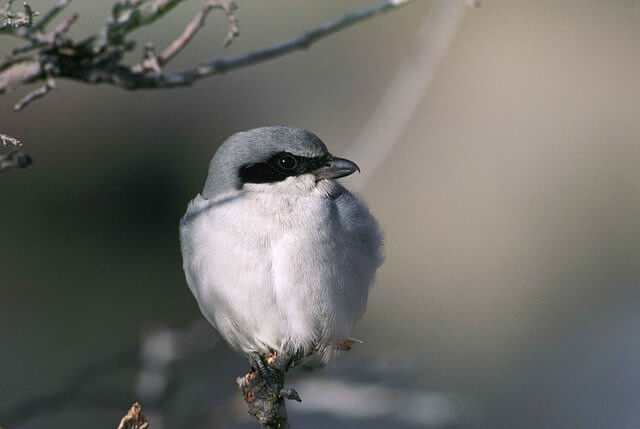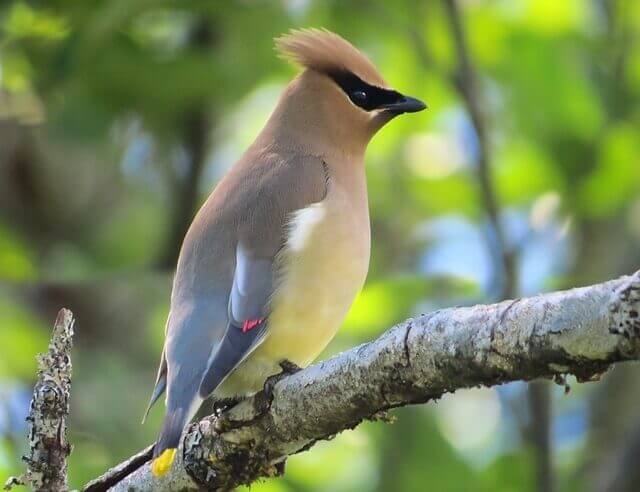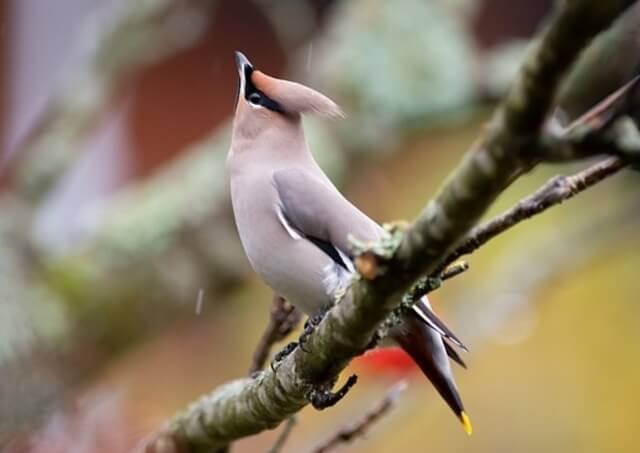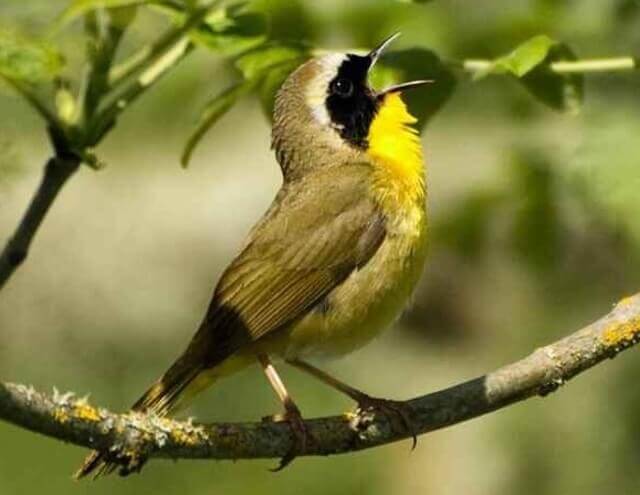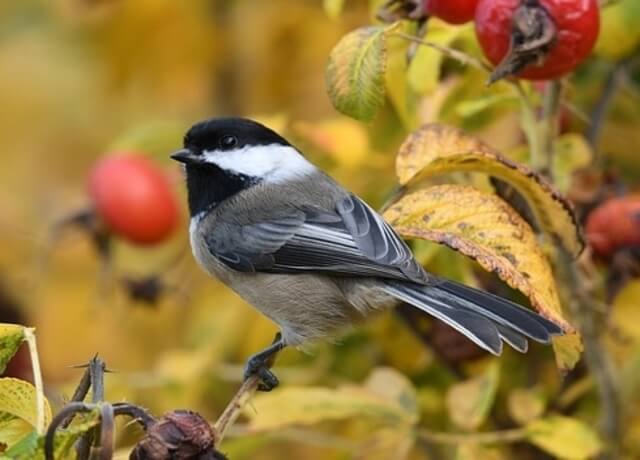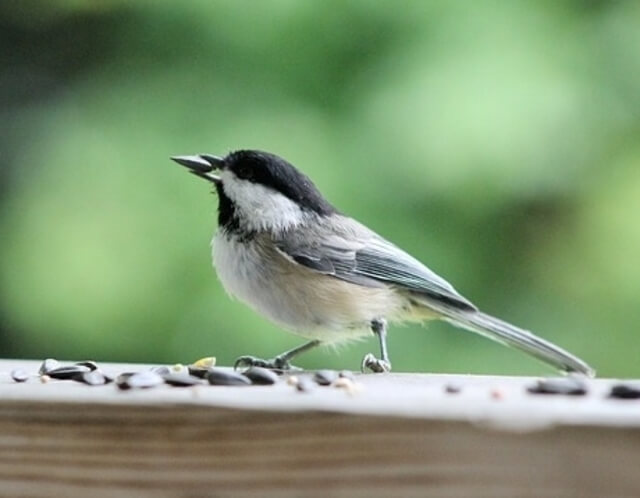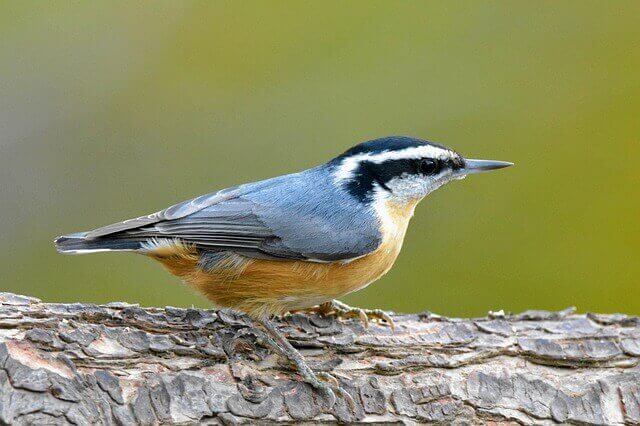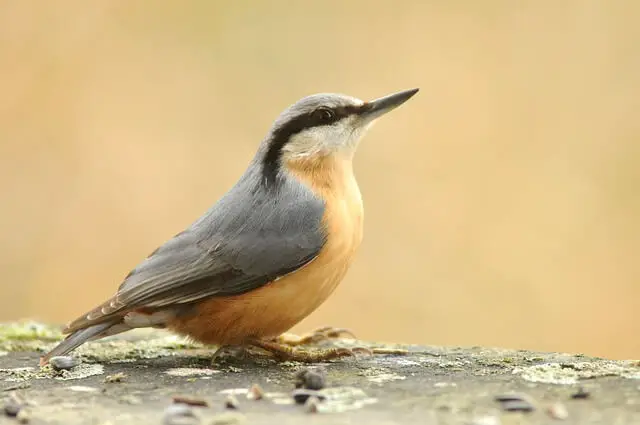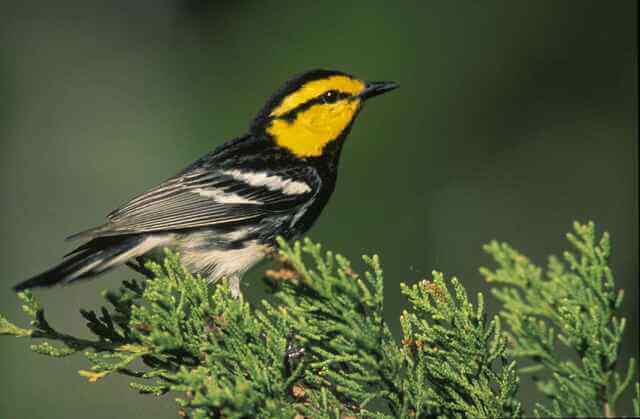Welcome to our guide where we explore 11 small birds adorned with a distinctive black mask. Delve into their unique traits, habitats, and behaviors, featuring captivating species like the black-capped chickadee and yellow-rumped warbler. Whether you’re a bird enthusiast or curious nature lover, join us on this journey to discover these charming feathered friends.
Table of Contents
Types of Small Birds with a Black Mask
Loggerhead Shrike
The Loggerhead Shrike is a type of bird that lives in the Northern Hemisphere. This bird has a gray head and back, white underparts, black wings with white bars on the leading edge of the wing, and a black mask over the eyes.
They are found in the temperate regions of North America, from southeastern Canada to northern Mexico and also in South America as far south as Peru. The Loggerhead Shrike’s diet consists mainly of insects, including beetles, wasps, bees, dragonflies and grasshoppers.
- Length: 7.8-9.0″ in (19.8-22.9 cm)
- Weight: 1.2-1.8 oz (35-50 g)
- Wingspan: 11.0-12.5″ in (28-31.8 cm)
Cedar Waxwing
Cedar Waxwings have a light brown head and chest, with gray wings and tail. The tail has a yellow tip. Its has a black mask over the eyes. It also has a small red patch on the wing feathers. These birds live in the eastern United States, Canada and Mexico where they breed as well as migrate during winter months to Central America.
They live in deciduous forests and can be seen on both coasts of North America. The diet of these birds consists mainly of berries, fruit, nectar and insects, but they will also eat seeds from trees such as juniper or mountain ash.
- Length: 5.1-7.0″ in (13-18 cm)
- Weight: 1.1 oz (32 g)
- Wingspan: 8.5-11.7″ in (21.6-29.7 cm)
Bohemian Waxwing
The Bohemian Waxwing is a North American bird that can be found all year round in most of the United States and Canada east of the Rocky Mountains. This bird has a grayish brown head and chest, with gray wings and tail. Its most notable feature is its black mask with a peach pink tint surrounding it. It also has a small red patch on both wings, and a yellow tipped tail.
The Bohemian Waxwing’s habitat is typically found near open woodlands or fields with berries, brambles, dogwood trees, evergreens or fruit bearing shrubs. They migrate to Mexico and Central America in the winter, while some may stay as far north as southern Canada.
- Length: 5.9 – 7.9″ in (15-20 cm)
- Weight: 1.6 – 2.4 oz (45-70 g)
- Wingspan: 13.1″ in (33.3 cm)
Common Yellowthroat
The Common Yellowthroat is a small songbird in the New World warbler family. They are identified by their black mask with a dark yellowish-green upper parts and bright yellow underside. The males are much brighter than the females, but both sexes have a black bill. This bird can be found throughout North America, Central America, and South America.
These birds mainly eat insects, worms, spiders, berries and some seeds during breeding season which usually lasts from April to July but sometimes lasts until September or October depending on where they live. It spends its time on the ground or low to mid-level of vegetation in damp meadows, reed beds, bogs, ponds and watercourses.
- Length: 4.0 – 5.5″ in (10-14 cm)
- Weight: 0.3 – 0.3 oz (9-10 g)
- Wingspan: 5.9 – 7.9″ in (15-20 cm)
Black-capped Chickadee
The Black-capped Chickadee is a small songbird with a black cap, and bib, white cheeks, and a gray upper body. This small bird can be found in the temperate regions of North America. Black-Capped Chickadees range from southern Canada to northern Mexico and as far west as Arizona and New Mexico.
Their habitat includes forests, brushy thickets, marshes and even urban parks. They are omnivores, feeding on seeds, nuts, berries, fruits and insects like ants, beetles and caterpillars which they find in trees or on the ground. During the winter months they migrate south into Mexico for the winter where they spend their time eating suet from bird feeders as well as pine nuts.
- Length: 4.3 – 5.9″ in (11-15 cm)
- Weight: 0.3 – 0.5 oz (9-14 g)
- Wingspan: 5.9 – 8.7″ in (15-22 cm)
Carolina Chickadee
The Carolina Chickadee is a small songbird with a black cap, and bib, white cheeks, and a gray upper body. This little bird can be found in eastern North America as well as northern Central America. Carolina Chickadees can be found year-round in forested areas, where they spend time foraging on the ground or on low branches.
They mainly eat insects during the winter months when they visit us in the north; their summer diet is mostly berries. The Carolina Chickadee migrates seasonally within its range according to food availability and climate change patterns, and it will leave North America during winter months when food sources are scarce.
- Length: 3.9 – 5.0″ in (10-13 cm)
- Weight: 0.3 – 0.4 oz (8-12 g)
- Wingspan: 5.9 – 8.3″ in (15-21 cm)
Red-breasted Nuthatch
The Red-breasted Nuthatch is a small, solitary bird that is found throughout North America. This bird has bluish-gray upper parts with a black cap and thin black mask, separated by a white stripe above the eye. The underparts are cinnamon colored. These birds inhabit deciduous and mixed forests, but they are also found in human inhabited areas.
The species feeds on insects and seeds during the summer months and nuts, berries, buds of flowers during the winter. They will often migrate during winter time for warmer climates like Florida or Mexico. The nuthatches will travel to different locations for mating season; these migrations can be up to 1,000 miles long.
- Length: 4.3 – 4.7″in (11-12 cm)
- Weight: 0.3 – 0.5 oz (8-13 g)
- Wingspan: 6.7 – 8.3″ in (17-21 cm)
Eurasian Nuthatch
The Eurasian Nuthatch is a common resident in the temperate zones of Europe and Asia. It is characterized by its blue-gray upper parts with a thin black mask over the eyes and a long black beak. Its underparts are white with a very light orange tinge. Eurasian Nuthatches feed on insects found in bark crevices of trees, nuts, seeds, acorns, and it also eats fruits such as hawthorn berries during late summer months.
This bird has a wide range of habitats, with the species occupying areas from high mountain ranges to lowland forests and scrubland. In winter, it migrates south to warmer climates, where it can find food more easily.
- Length: 4.3 – 4.7″ in (11 -12 cm)
- Weight: 0.3 – 0.5 oz (8-13 g)
- Wingspan: 7.5 – 8.3″ in (19-21 cm)
Golden-winged Warbler
The Golden-Winged Warbler is a bird species that lives in the southern parts of Canada and the United States. The habitat of this bird ranges from forests to marshes, and they can be found mostly in Georgia, Louisiana, Mississippi, Arkansas, Texas and Missouri. This bird migrates during the winter months when it moves south into Mexico for warmer weather.
The Golden-winged Warbler is a small, gray bird with a black mask and throat, yellow crown, and big yellow spots on the wings. They are known to be near threatened because of deforestation from logging operations and coal mining. This species mainly eats insects such as caterpillars, ants, beetles, bees and wasps.
- Length:4.5 – 4.7″ in (11.4-11.9 cm)
- Weight: 0.28 – 0.35 oz (8–10 g)
- Wingspan: 7.9″ – 8.1″ in (20.0-20.5 cm)
Golden-cheeked Warbler
The Golden-cheeked Warbler is a small songbird that lives in dense, lowland forests. It is most commonly found in Central Texas and the Edwards Plateau of West Texas. This bird is a species of conservation concern due to habitat loss and degradation from human activities such as logging, oil drilling, and ranching.
The Golden-cheeked Warbler can be identified by its black upper body and white under body as well as its bright orange yellow cheeks, dark black wings, and two thin wing bars. Its head has a black cap, and it also has a black nape and throat. There is also a thin mask over the eyes that is black in coloration. The Golden-cheeked Warblers are omnivores that eat a variety of food, including insects, fruits, seeds, flowers and leaves.
- Length:4.5 – 4.7″ in (11.4-11.9 cm)
- Weight: 0.28 – 0.35 oz (8–10 g)
- Wingspan: 7.9″ – 8.1″ in (20.0-20.5 cm)
Townsend’s Warbler
Townsend’s Warbler is a rare bird that lives in the northwestern United States and southwestern Canada. This Warbler has black crest and throat, with a bright yellow face and black face mask. They have gray wings with white wing bars, a dark yellowish-green back, with a yellow breast with distinct black streaks on the flank.
The Townsend’s Warbler can be found throughout boreal forests, and during migration, it spends time in moist temperate coniferous forests as well. It eats insects and small invertebrates such as spiders, flies, beetles, butterflies, dragonflies etc. The Townsend’s Warbler has a very specific habitat range, which is why they are at risk for extinction due to deforestation.
- Length: 4.7 – 5.1″ in (12-13 cm)
- Weight: 0.3 – 0.4 oz (7.3-10.4 g)
- Wingspan: 7.1 – 8.7″ in (18-22 cm)


